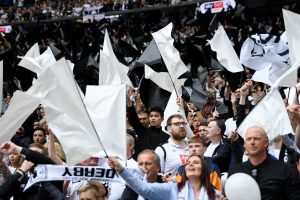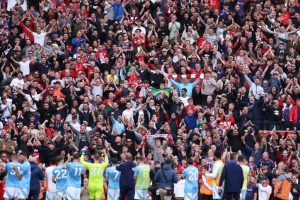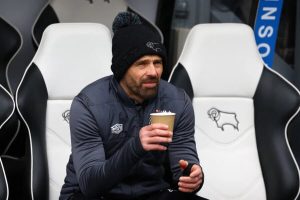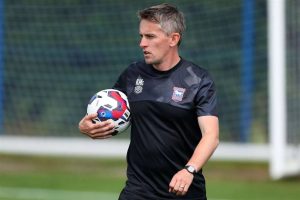
Michael Harris II and Spencer Strider were once unknown talents before becoming high-level Major Leaguers.

The same could be said about Atlanta’s top catching prospect, Drake Baldwin.
The southpaw advanced through the Braves’ MiLB system in 2023, beginning in High-A and finishing in Triple-A. Now in 2024, Baldwin has had his most productive and thrilling season ever, prompting the Braves to invite him to the 2024 All-Star Futures Game.
With Baldwin blazing in Triple-A and demonstrating that his bat is nearly ready for the major leagues, the Braves will soon be faced with a difficult decision. Do they keep Baldwin in the minors for development?
Call him up to provide an offensive lift to the major league team?
Or would they rather include him in a trade at the deadline to address other roster needs?
His recent Triple-A success and outstanding performance in the Futures Game have piqued the interest of both fans and teams.
Early Pro-Career
Baldwin was taken in the third round of the 2022 MLB Draft and signed for around $630,000. The former Missouri State backstop began his career with a brief run in the complicated league before finishing the 2022 season at Low-A.
As previously indicated, Baldwin advanced through the Braves organization in 2023, stopping at High-A, Double-A, and Triple-A, but he spent the majority of his time at High-A Rome.
While in Rome, Baldwin hit.260/.385/.466, good for a 135 wRC+. Baldwin’s scouting reports after college said he was a power-over-hit man, which he verified by hitting 14 home runs in 92 games.
He began the 2024 season at Double-A Mississippi and had a slower start than planned. Baldwin’s stats plummeted dramatically over the course of 52 games. He was striking out more, hitting for power less frequently, and overall was a poorer version of himself than his stellar 2023 season.
2024 Promotion to AAA
Despite only having a 94 wRC+ in Double-A this season, Baldwin was promoted to Triple-A Gwinnett alongside another top Braves prospect, Nacho Alvarez Jr.
This was remarkable given Baldwin’s difficulties and step back in production. However, the outcomes since moving to Gwinnett have been extraordinary.
As of July 12th, Baldwin is slashing.309/.440/.532. He has already hit six home runs and three doubles, with more walks than strikeouts.
| Drake Baldwin | PA | AVG | OBP | SLG | HR | BB% | K% | wRC+ |
| 52 Games at Double-A | 217 | .244 | .313 | .337 | 4 | 9.2% | 18.9% | 94 |
| 24 Games at Triple-A | 116 | .309 | .440 | .532 | 6 | 19% | 12.9% | 155 |
The overall improvement is astounding. He has taken Triple-A by storm. He has the seventh highest wRC+ (min. 100 plate appearances) and is one of only three players with a wRC+ above 150 who walk more often than strike out. The other two are José Fermín and Spencer Horwitz.
Perhaps the most striking aspect of Baldwin’s profile is his contact rates. Not only is he in the 98th percentile (AAA) for 90th percentile exit velocity and average exit velocity, but he also makes contact at a 93% rate.

His swing decisions have greatly improved, with less pursuit and fewer whiffs. His SEAGER (a metric that measures a hitter’s decision-making by calculating Z-Swing% – O-Swing%) is outstanding, indicating that Baldwin is maturing quickly.
Futures Game Performance
His good job has not gone unnoticed. He was the Braves’ only representative in the 2024 All-Star Futures Game. Last year, the Braves sent RHP Spencer Schwellenbach, who has recently performed admirably for the major league team.
Baldwin was the National League team’s designated hitter, hitting ninth in the lineup. In three plate appearances, he was 1-for-2 with two RBI. The first RBI came on a sacrifice fly off Astros RHP prospect A.J. Blaubaugh.
The second RBI was a single home run into left-center field, putting the NL Futures ahead 5-1.
Braves prospect Drake Baldwin goes deep!
This one left the bat at 107.3 mph🤯 pic.twitter.com/2obHyZ8GiT
— The Call Up | An MLB Prospect Podcast (@The_CallUpPod) July 13, 2024
Fernando Perez, a Blue Jays RHP prospect, hit the home run on a 3-1 pitch with a 93 MPH fastball.
The ball left Baldwin’s bat at 107.3 mph, making it the game’s hardest-hit ball. Yes, Baldwin’s opposite-field home run was the hardest hit ball in a contest stacked with the world’s best baseball prospects.
It also traveled 411 feet, making it the longest-hit ball in the game. Baldwin was already establishing a reputation for himself in Braves Country, but his performance in the Futures Game will introduce an entirely new audience to the slugger that is Drake Baldwin.
Despite Baldwin’s lead in RBI and home runs, Reds prospect Cam Collier was chosen game MVP. Collier hit a 409-foot home run in the top of the third.
Baldwin was one of three National League catchers, along with Just Baseball’s #18 overall prospect Ethan Salas of the Padres and Just Baseball’s #67 overall prospect Thayron Liranzo of the Dodgers. While Baldwin is the only backstop not currently ranked in the Top 100, that could change in the near future.
The Future For Baldwin
Aram Leighton revealed on Episode #301 of The Call Up that Drake Baldwin is one of the players he is most looking forward to seeing in person for the first time. He even mentioned that Baldwin would break into the Top 100 list shortly.
A Potential Call-Up
Given how the Braves have handled prospects in the past, Drake Baldwin may see action in the Major Leagues sooner rather than later.
Strider and Harris, as well as Spencer Schwellenbach, were called up ahead of most prospects. The Braves essentially alternate between Travis d’Arnaud and Sean Murphy every game, with Chadwick Tromp serving as the third catcher.
An injury to either d’Arnaud or Murphy would most likely provide Alex Anthopolous with the perfect reason to call up Baldwin. Banking on a major leaguer’s injury isn’t the perfect path to the big leagues, but it appears to be the only one. Drake’s positional versatility is limited because he has spent his whole professional career as a catcher.
In terms of Baldwin’s likely 2024 debut, my expectations are mixed. His catching behind the plate, which was formerly rated as below average, has steadily improved as he has grown older.
His power output has continued to flourish in his game, and he makes plus-plus contact. His hit tool has really matured by 2024.
This is the same talent that had a hit tool that evaluators were unsure about when he entered the draft. At face value, the figures indicate confidence in his hit tool’s ability to be a consistent element of his game moving forward.
However, we can take a closer look to see what he would look like in the major leagues.
| Pitches | OPS | Swing & Miss% | |
| Fastballs | 249 | .961 | 16% |
| Breaking Balls | 133 | 1.261 | 36% |
| Offspeed | 74 | .653 | 21% |
| 95 MPH+ | 58 | .582 | 29% |
2024 Drake Baldwin vs. various pitch groups (AAA)
His ability to drive fastballs and breaking balls alike for damage is impressive, but the swing and miss at the breakers could become a problem at the next level. He’s struggled against offspeed pitches, too.
The biggest factor hindering his future value in the league at this current moment is the lack of results against plus velocity. Pitches that are 95 MPH or higher have crippled Baldwin’s production in Triple-A. He’s swinging through those pitches nearly 30% of the time.
Pair that with the poor whiff rates against breaking balls and we can see some clear holes in the catcher’s game at the plate. These issues that are below the surface at Triple-A would become far more apparent if he were to get the call to Atlanta. He still has things to work on and calling him up now might allow MLB pitchers to find these holes in his swing effectively. Mind you, this is a guy with just 128 plate appearances at Triple-A in his entire career, he’s still developing.
A fun thing I like to do with prospects is find MLB comparisons based on various advanced metrics using Python. This is done by comparing things like Z-Contact%, SEAGER%, 90th percentile EV, max EV, and Pull%.
| Z-Con% | SEAGER% | 90th EV | Max EV | Pull% | wRC+ | Distance | |
| Drake Baldwin (AAA) | 91.24% | 47.27% | 108.6 | 111.90 | 43% | 155 | N/A |
| Pavin Smith | 90.4% | 48.4% | 105 | 110.6 | 43.75% | 128 | 4.15 |
| Jurickson Profar | 89.3% | 45.8% | 105.3 | 109.7 | 41.8% | 159 | 4.79 |
| Christian Yelich | 87.6% | 44.1% | 108.4 | 113.2 | 42.7% | 163 | 5.01 |
| Corey Seager | 88.3% | 52.0% | 107.4 | 113.3 | 41.9% | 126 | 5.93 |
| Patrick Bailey | 87.5% | 44.1% | 104.88 | 109.7 | 43.2% | 128 | 6.55 |
Drake Baldwin’s MLB Comparisons as of 7/12 – *Distance measures how ‘close’ the player is to the comparison with 0.0 being the closest possible
These are incredibly intriguing comparisons. It’s important to note that these comparisons are not a set-in-stone reflection of how you can expect Baldwin to perform once he steps foot into a big-league batter’s box.
This is a small sample size of Baldwin seeing lower-level pitching compared to the five MLB players on this list with much larger sample sizes facing more difficult pitching.
Seeing the namesake of the SEAGER stat itself as the fourth closest MLB comparison on here can’t help but get me over the moon for Drake Baldwin’s potential, though. His batted ball data so far has been nothing shy of elite and improvements to the swing and miss on breaking balls as well as an adjustment to higher velocities would turn Baldwin into a surefire Top 100 prospect.
A Potential Trade Chip
As Braves and baseball fans in general know, Alex Anthopolous likes to play his cards close to his chest. He also isn’t keen on sending a young prospect with this kind of potential away, even if it means getting a piece that will improve the major league club immediately.
The Matt Olson and Sean Murphy trades sent prospects with far less excitement attached to their name. The biggest prospect in the Olson trade was Christian Pache. That was a situation that was much different from the situation at hand with Baldwin.
Pache had been given chances with the major league club and the prospect fatigue was growing rapidly for Pache in Atlanta. William Contreras was sent to Milwaukee in the three-team deal which sent a few of Atlanta’s young arms to Oakland and put Murphy in a Braves uniform. Parting with a talented player like Contreras was difficult but there was a direct and proven replacement.
Anthopolous will only pull the trigger on deals like this when he knows the Braves are going to win the trade and not lose out on a prospect on the verge of a breakout.
A Braves Fan held up their phone for GM Alex Anthopoulos saying “Trade for Dylan Cease”
“We already tried, We already tried. Too expensive” pic.twitter.com/1vVIMTdEP5
— Barstool Baseball (@StoolBaseball) January 31, 2024
Before being traded to the San Diego Padres, Dylan Cease was on Anthopolous’ radar. The Braves GM ultimately held back from the deal because the White Sox were asking for too much in return. The past several trade deadlines have seen the Braves make more lateral moves instead of massive overhauls for big names at the expense of Atlanta’s premium youngsters.
I have doubts that the Braves will trade for a big fish at this year’s deadline. Pair that with the current climate of the trade market where there are many teams on the brink of contention. This leads me to believe there is a small chance that the Braves decide to use Baldwin as a trade chip at this year’s deadline.
As I’ve mentioned, there are still aspects of Baldwin’s game that need to be improved. Luckily, he should have the opportunity to stick in Triple-A for enough time to do so.
Travis d’Arnaud has an $8 million club option for 2025 and depending on Baldwin’s progression through the rest of the season, the Braves could see a chance to save some money and move on from the veteran d’Arnaud. Sean Murphy signed an extension that made him a Brave through the 2028 season, with a club option for 2029.
Since Baldwin is a left-handed hitter, there could be a chance to platoon Murphy and Baldwin in the coming years. While also being able to DH one, while starting the other on occasion, as we have seen the Braves do with Muprhy and d’Arnaud.
The immediate future remains to be seen for Baldwin. However, one thing is for sure; Drake Baldwin is one of the most exciting young prospects not only in the Braves farm system, but in the entirety of the minor leagues.







